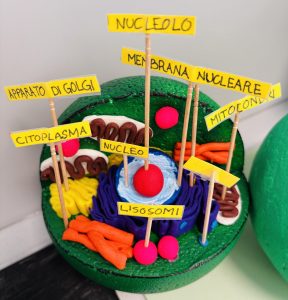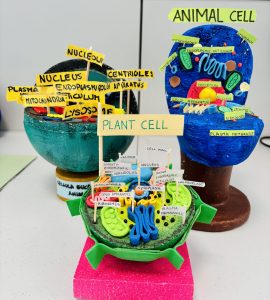L’importanza dell’attività laboratoriale nella comprensione dei concetti scientifici
Gli studenti delle classi prime Middle hanno dato vita a un entusiasmante progetto scientifico: la realizzazione di modellini tridimensionali delle cellule eucariote e procariote. L’attività, inserita nel programma di scienze, ha permesso ai ragazzi di approfondire in modo pratico e coinvolgente le caratteristiche delle unità fondamentali della vita.
Con cartone, plastilina, polistirolo e materiali di riciclo, gli studenti hanno riprodotto fedelmente le strutture cellulari, distinguendo tra cellule animali e vegetali e confrontandole con le cellule procariote, più semplici ma altrettanto affascinanti. Ogni alunno ha lavorato con impegno per rappresentare fedelmente le membrane, il nucleo, i mitocondri e gli altri organuli che caratterizzano le cellule eucariote, nonché le strutture tipiche delle cellule procariote, come la parete cellulare e il flagello.
La realizzazione di un modellino aiuta gli alunni a comprendere meglio la differenza tra i due tipi di cellule e a memorizzare le loro funzioni, l’apprendimento passa attraverso l’esperienza diretta. Toccare con mano e costruire un modello aiuta gli studenti a interiorizzare i concetti in modo più efficace rispetto alla sola memorizzazione delle informazioni.
Questa iniziativa ha stimolato la curiosità scientifica, dimostrando quanto sia fondamentale l’approccio pratico nella didattica delle scienze. Grazie a questa esperienza, i giovani studenti non solo hanno acquisito conoscenze teoriche, ma hanno anche sviluppato creatività e problem-solving, competenze essenziali per il loro percorso scolastico e per il loro futuro.
L’impegno profuso da parte degli studenti ha confermato che la scienza, quando si tocca con mano, diventa ancora più affascinante!
FIRST-YEAR STUDENTS AT OUR MIDDLE SCHOOL CREATE CELL MODELS: A JOURNEY INTO THE WORLD OF BIOLOGY
The importance of hands-on activities in understanding scientific concepts
The first-year middle school students have embarked on an exciting scientific project: creating three-dimensional models of eukaryotic and prokaryotic cells. This activity, part of the science curriculum, allowed students to explore the fundamental units of life in a practical and engaging way.
Using cardboard, clay, polystyrene, and recycled materials, students faithfully reproduced cellular structures, distinguishing between animal and plant cells and comparing them with prokaryotic cells, which are simpler yet equally fascinating. Each student worked diligently to accurately represent membranes, the nucleus, mitochondria, and other organelles characteristic of eukaryotic cells, as well as the typical structures of prokaryotic cells, such as the cell wall and flagellum.
Creating a model helps students better understand the differences between the two types of cells and memorize their functions. Learning happens through direct experience—touching and building a model allows students to internalize concepts more effectively than mere memorization.
This initiative has sparked scientific curiosity, demonstrating the fundamental role of hands-on learning in science education. Thanks to this experience, young students have not only gained theoretical knowledge but also developed creativity and problem-solving skills, essential competencies for their academic and future careers.
The dedication and effort shown by the students have confirmed that science becomes even more fascinating when experienced firsthand!








